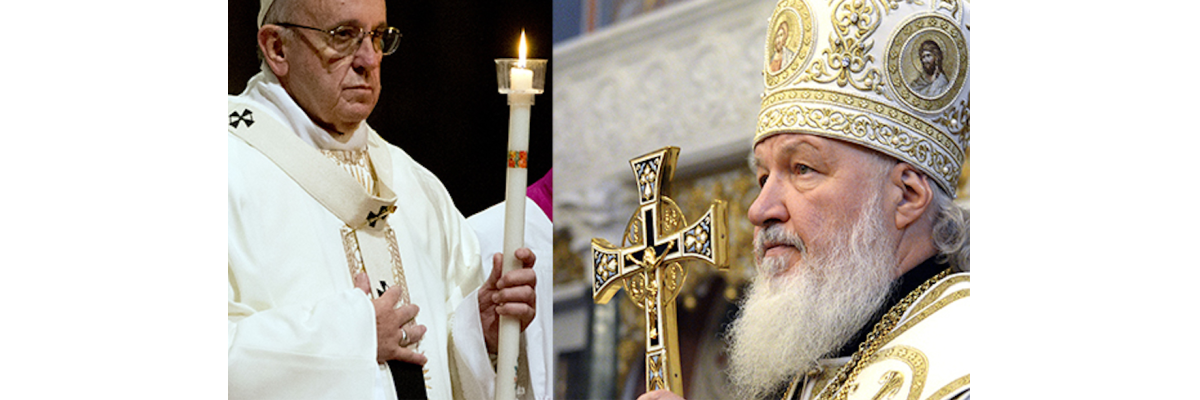
Today Pope Francis met with Patriarch Kirill of Moscow in Havana, Cuba, with the hope of bettering relationships between the Catholic and Eastern Orthodox churches. According to NBC News:
“Finally!” Francis exclaimed as he embraced Kirill in the small, wood-paneled VIP room of Havana’s airport, where the three-hour encounter was taking place. “We are brothers.” They kissed one another three times on the cheek, and Kirill told the pope through an interpreter: “Now things are easier.”
NPR also published an article on the meeting but it included a fair number of inaccurate statements about the relationship between Catholics and Eastern Orthodox. According to the article:
Catholic clergy are celibate, while Eastern or Orthodox clergy are allowed to marry. The churches also differ in the practice of the eucharist or communion ritual. The Roman Catholic Church uses unleavened bread for the communion host, while the Orthodox churches use leavened bread.
“There were even disagreements on a real deep theological level about the Trinity, concerning the relation between the Father, the Son, and the Holy Spirit,” says Brett Whalen, a professor of medieval studies at the University of North Carolina.
Differences in custom and practice, such as how to administer the Eucharist, lie not between Catholic and Orthodox churches but between the Western and Eastern Churches in general. The largest rite in the Catholic Church is the Roman or Latin rite in the West. However, there are many other Catholic rites in the East that possess the same customs as those found in Eastern Orthodox churches.
For example, Byzantine Catholic churches use leavened bread in their liturgies, and they follow the Eastern practice of administering the Eucharist to infants after they have received confirmation (or what is called chrismation).
When it comes to marriage, priestly celibacy is the discipline within the Latin rite, whereas married men in Eastern rites may be admitted to the priesthood. (In many parts of the world, the Latin rite allows married Protestant clergymen who become Catholic to be ordained priests with a dispensation from the priestly vow of celibacy, but this is an exception to the rule.) However, an Eastern priest may not marry after he is ordained (similar to how Roman-rite deacons may be married but cannot remarry after the death of their spouse), and Eastern priests may not proceed to the bishopric unless they are widowed or unmarried (Eastern Code of Canon Law 180.3).
In regards to the issue of the Trinity, centuries of theological discussion have brought the two Churches close together on the subject. The main point of disagreement is the filioque clause in the Creed that says the Holy Spirit proceeds from the Father “and the Son.” Eastern Orthodox say the Holy Spirit proceeds solely from the Father, but if one understands that everything the Son has ultimately comes from the Father who begot him, then these two formulations can be equally accurate. According to the Catechism of the Catholic Church, “This legitimate complementarity, provided it does not become rigid, does not affect the identity of faith in the reality of the same mystery confessed” (248).
When it comes to the differences in discipline and even the vocabulary used to express doctrine (Eastern Catholics call Mass “the Divine Liturgy,” for example) the Second Vatican Council taught:
Variety within the Church in no way harms its unity; rather it manifests it, for it is the mind of the Catholic Church that each individual Church or Rite should retain its traditions whole and entire . . . although they differ somewhat among themselves in rite (to use the current phrase), that is, in liturgy, ecclesiastical discipline, and spiritual heritage, are, nevertheless, each as much as the others, entrusted to the pastoral government of the Roman Pontiff, the divinely appointed successor of St. Peter in primacy over the universal Church” (Orientalium Ecclesiarum, 2-3).
This brings us to the biggest difference between Eastern Catholic and Eastern Orthodox Churches: the papacy. According to NPR:
“It really isn’t until the eleventh century that you see the pope really starting to emphasize and assert authority as the head of the church,” Whalen says. “This contributes to generating some new antagonisms with the [Orthodox] church. That led to Pope Leo IX’s excommunication of the patriarch of Constantinople—who returned the favor and in turn excommunicated the pope.”
There is evidence of Eastern patriarchs recognizing the primacy and authority of the Bishop of Rome long before the eleventh century. For example, St. Ignatius of Antioch referred to the Roman Church as the one that teaches other churches and “presides in love” over them. In fact, the writings of Pope Clement (A.D. 92-99) and Pope Soter (A.D. 167-174) were so popular that they were read in the Church alongside Scripture (Eusebius, Church History 4:23:9).
In A.D. 190, Pope St. Victor I excommunicated an entire region of churches for refusing to celebrate Easter on its proper date. While St. Irenaeus thought this was not prudent, neither he nor anyone else denied that Victor had the authority to do this. Indeed, Irenaeus said, “it is a matter of necessity that every Church should agree with this Church [Rome] on account of its preeminent authority” (Against Heresies 3.3.2).
In the fourth century, the Council of Constantinople declared that, “The bishop of Constantinople shall have the primacy of honor after the bishop of Rome, because his city is New Rome” (canon 3). Constantinople was called “new Rome” because of Emperor Constantine’s decision to move the imperial capital there, but the patriarchs in the region understood that their authority was still under the primacy of Rome, because the bishop of Rome was the successor of St. Peter.
When it comes to the matter of who excommunicated whom in the Great Schism, you should know that the story is more complex than what NPR lets on and is summarized well in our tract Eastern Orthodoxy. I will simply quote its conclusion:
There was no single event that marked the schism, but rather a sliding into and out of schism during a period of several centuries, punctuated with temporary reconciliations. The East’s final break with Rome did not come until the 1450s . . . in 1453 a soldier forgot to lock one of the gates of the fortified city of Constantinople, and the Turks sacked the city. With the Turks in control of the capital city, the rest of the empire crumbled quickly. Under pressure from Muslims, most of the Eastern churches repudiated their union with Rome, and this is the split that persists to this day.
Please pray that Pope Francis’s meeting with the Patriarch sows the seeds for our two churches to become one again, just as Jesus prayed for his church (John 17:21). Also, check out this great article by my colleague Jimmy Akin that explains the differences between Catholic and Eastern Orthodox churches and why he ultimately chose to become a Roman Catholic.
An outstanding and detailed explanation of the differences between the Catholic and Eastern Orthodox churches is The Russian Church and the Papacy by Vladimir Soloviev (1853-1900), a Russian Orthodox theologian who was condemned by his church for his efforts at Christian unity. Pope St. John Paul II called Soloviev one of the modern era’s great “witnesses of the faith and illustrious Christian thinkers.” The book is available from Catholic Answers Press through Amazon.com.



